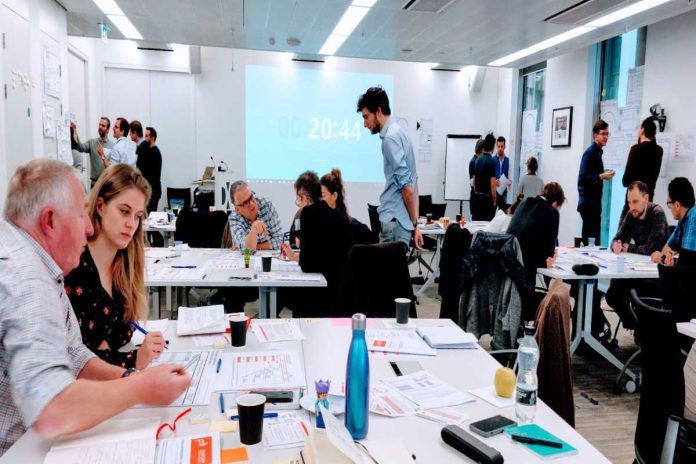Table of Contents
Product Design Workshops
The traditional way of organizing communications during the development of a new product is vertical. The client communicates their wishes to the company’s management. Top management forms its vision of the project, team leaders set technical tasks, and direct performers receive specific tasks within their competence. Effective? Not always. To get rid of the disadvantages of this approach, many companies introduce innovative methods, such as design workshops. We tell you more about them.
What Are Design Workshops?
Design workshops are an original form of teamwork designed to develop a realistic vision of goals and collect unbiased opinions on how to achieve them. Their differences from traditional meetings are:
- Participation of three parties — customer (stakeholder), management, and executors. The vertical way of organizing communications is replaced by a horizontal one. Each party can express its opinion and get an idea of the progress of the project.
- Narrow focus — as a rule, one goal at a time is discussed at design workshops. This approach helps to focus on specific tasks achievable in the foreseeable future and not to waste unnecessary time.
- A clear structure of active communication. Design Workshops are built on the basis of simple logic. They gather, discuss, screen, prioritize, and analyze different opinions. These events have a rigid schedule that typically spans between 4 and 12 hours.
5 Reasons Why Design Workshops Are the Future of Corporate Communications
1. Increased efficiency
The traditional vertical approach means a tremendous waste of time. Each stage of communication is a separate meeting that takes up a significant portion of the workday. There’s a reason why the “It could have been an email!” meme has become popular in IT.
A design workshop allows you to use your working time more efficiently. All issues are solved in one meeting with a clear schedule. Each topic is given due attention at all levels — from the client to the direct executor.
The workshop also saves time in turning conceptual plans into technical tasks and breaking down general goals into specific tasks. It involves both team leaders and staff members who see the big picture. As a result, they can navigate the project faster and get to their work as soon as possible.
2. Finding compromises
One of the biggest challenges in the technology industry is the mismatch between business goals and user needs. A product often turns out to be convenient for its developers but not for the target audience. This is especially important to consider in the experience design industry, where up to 35% of losses are due to the lack of compromises.
During the design workshop, different opinions are discussed:
- Developers talk about technological limitations and optimization methods;
- Management forms a working business model;
- Customer defends the interests of the end user.
Structured communications allow for analyzing each idea within one meeting. By discussing all possible options, participants manage to “stop somewhere in the middle,” creating a viable product concept.
3. Generating new ideas
When setting a task, customer representatives and top management may not be aware of certain technologies and functions. By communicating with the direct executors, they get the missing information. This allows them to change the idea behind the project.
When we consider software development, we are usually talking about additional application modules that add value to the product for the end user. The earlier they are incorporated into the project, the less time, effort, and money will be spent on their creation. That is why it is very important to hold business workshops at the very beginning of the project.
In addition, during such a meeting, the customer may propose a number of ideas that will be evaluated by the executors. The task of management in such a case will be to collect honest unbiased feedback that will allow for evaluating the rationality of adding such features to the final product.
4. Minimizing risks
Many successful ideas never turn into successful business models due to underestimation of risks. That is why the topic of many workshops is not the advantages but the disadvantages of projects:
- Missing features that are really needed;
- Difficulties in realizing the main ideas;
- Possible delays at each stage;
- Probable changes in the market situation at the time of product release;
- Rapid development of competitors, and so on.
A successful business workshop allows for a thorough review of each source of risk. Based on the results of the meeting, decisions can be made to change development timelines, add or remove certain features, use alternative methods, or enter other markets.
5. Establishing internal communications
An important benefit that is often overlooked. During workshops, specialists working on different areas get to know each other. They exchange ideas, assess the professional level of their colleagues, and assign responsibilities.
All this allows for well-structured internal communications. Instead of addressing a message to management, an employee can directly address a specific specialist, saving time and company resources. It may seem like a small thing, but it’s the little things that make up the productivity gains.
Conclusion
Design workshops can rightly be called the future of corporate communications. They are traditional meetings — clearly structured, productive, and cost-effective. They result in specific decisions that affect the future of the product. These workshops help to find compromises and avoid mistakes. With their help, it is possible to establish internal communications and minimize risks for the company.

